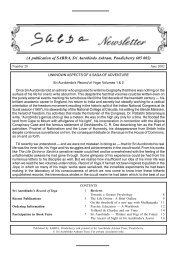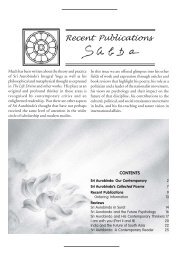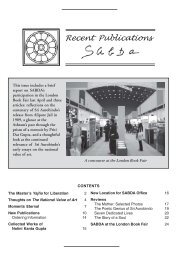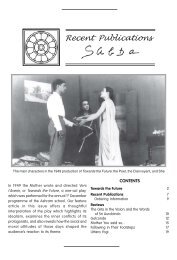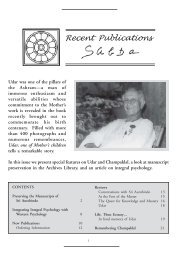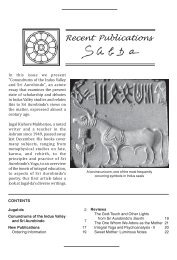Recent Publications - Sabda - Sri Aurobindo Ashram
Recent Publications - Sabda - Sri Aurobindo Ashram
Recent Publications - Sabda - Sri Aurobindo Ashram
You also want an ePaper? Increase the reach of your titles
YUMPU automatically turns print PDFs into web optimized ePapers that Google loves.
10 <strong>Recent</strong> <strong>Publications</strong>talks. A. S. Dalal’s continuing series has served this purpose,as have the compilations specifically made to explainthe practice of the yoga. Three works of this kind makingsubstantial use of <strong>Sri</strong> <strong>Aurobindo</strong>’s letters are Bases of Yoga,A Practical Guide to Integral Yoga and The Integral Yoga:<strong>Sri</strong> <strong>Aurobindo</strong>’s Teaching and Method of Practice.Now into this pool of literature meant to make thepractice of the Integral Yoga more accessible, has comeJugal Kishore Mukherjee’s The Practice of the IntegralYoga. This work is not a compilation of <strong>Sri</strong> <strong>Aurobindo</strong>’sletters on yoga or of the Mother’s talks; nor is it a primer ofyoga practice in the style of M. P. Pandit. Yet, in a way, itThis book brings togethersome of the most helpfulquotes from <strong>Sri</strong> <strong>Aurobindo</strong> andthe Mother, weaving theminto its text in contextual wayswhich make them much morepotent than in their isolatedplacement in compilations.is all these and more.Springing from theauthor’s many yearsas a teacher at the<strong>Sri</strong> <strong>Aurobindo</strong> InternationalCentre ofEducation, its proseis marked by thefriendly enthusiasmof sharing thoughhardly lacking in theanalytical rigor forwhich Jugal Kishore has become well known. At 350 oddpages, the paperback is not verbose, is easy to read,perceptive and practical. Best of all, it brings togethersome of the most helpful quotes from <strong>Sri</strong> <strong>Aurobindo</strong> andthe Mother, weaving them into its text in contextual wayswhich make them much more potent than in their isolatedplacement in compilations.In its organization of materials, the book displays theworking of an incisive selecting intuition which picksout the most relevant aspects from all the major yogicworks of <strong>Sri</strong> <strong>Aurobindo</strong> to form its chapters. Thus, thoughthe contents of the chapters derive their effectivenesslargely from quotes taken from <strong>Sri</strong> <strong>Aurobindo</strong>’s letters andthe Mother’s talks, the focus and logic of the chaptersseem to be drawn from The Mother and The Synthesis ofYoga. In this, it appears the author gives primacy ofposition to The Mother as the principal practical text ofthe Integral Yoga – a refreshing and penetratingly directapproach seldom seen before in books of this kind.After spending the first two chapters developing, fromthe Mother’s practical hints, some basic daily attitudesand habits of sadhana (corresponding to the yamas andniyamas of other schools, though much more subtle andpsychological in this case), the author launches into eightchapters based on the approaches developed by<strong>Sri</strong> <strong>Aurobindo</strong> in The Mother. The first five of these chapterselaborate on the famous triple formula of “aspiration,rejection and surrender.” In the process the author clarifiescontext and specialized sense pertaining to these termsand repeatedly invokes the key inner movements of theyoga. For example, before embarking on a discussion ofsurrender (Ch. VII, “On Self-surrender to the Divine”), theauthor prepares the ground by interposing a chapter “OnOpening and Receptivity.” In this chapter, the primacy ofthese two terms “opening” and “receptivity,” which <strong>Sri</strong><strong>Aurobindo</strong> evokes as central in The Mother is discussedso as to awaken the reader to their meaning, importanceand inner intuition. Quotations such as the followingabound, which leave one in no doubt that (1) this yoga isdone not by one’s unaided effort but by reliance on theMother’s Force; and (2) becoming aware of the working ofthe Mother’s Force as soon and as completely as possibleis among the most important necessities of this yoga: “Byremaining psychically open to the Mother, all that is necessaryfor work or Sadhana develops progressively, that isone of the chief secrets, the central secret of the Sadhana.”After these chapters on aspiration, rejection and surrender,the author returns to the first line of The Mother (whichI have quoted earlier in this review). The two powers “thatalone can effect … the aim of our endeavour,” the “call”and the Grace, are here taken up in separate chapters. Inchapter VIII, the author engages in a most interesting andilluminating discussion relating to the “call” vis-à-visprayer. The forms of and differences between aspirationand prayer are here brought out in bold relief. Grace isdealt with in two succeeding chapters – “How to Invokethe Divine’s Grace?” and “Personal Effort and the DivineGrace.” This focus on Integral Yoga as seen through TheMother is then followed by chapters which elaborate thesadhana as dealt with in The Synthesis of Yoga.Here, the discussion revolves at first around the Yoga ofWorks, then the Yoga of Love and then the Yoga of Knowledge.Important elements of these aspects of sadhana arebrought together in these chapters, such as the problem ofright action in the Yoga of Works, the place of humanrelationships in the Yoga of Love and practical and legitimateaspects and methods for meditation in the Yoga ofKnowledge. The development and transformation of thewill, the premier importance of equality and its constantpractice and the meaning and methods of psychic awakeningare succeeding concerns considered in followingchapters before approaching the perfection of the mentalvital-physical-subconscientinstrumentality of the sadhaka.



